Home Tags Posts tagged with "federal aviation administration"
federal aviation administration
A computer glitch has grounded all American Airlines flights from Miami, Dallas and Chicago, the Federal Aviation Administration (FAA) has announced.
According to the FAA, American Airlines requested to hold departures at the Miami, Dallas Fort-Worth and Chicago O’Hare airports.
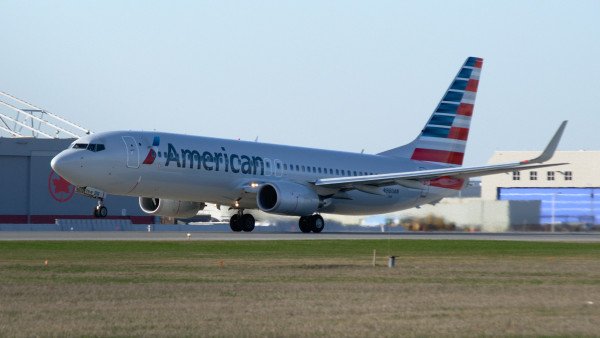
Photo Wikipedia
In response to passengers’ complaints on Twitter, American Airlines said it was having technical issues.
The FAA expects to lift the hold – which began about 12:00 local time in Miami – shortly.
Passengers hoping to get to their destinations on time are not hesitating to tell American Airlines they are unhappy.
The Federal Aviation Administration (FAA) has ordered airlines to replace or modify the cockpit display units fitted to hundreds of Boeing jets.
The US air safety regulator said that tests had indicated that mobile phone and computer signals could cause the screens to go blank.
The affected planes are typically fitted with several screens, each of which costs thousands of pounds.
Honeywell – the displays’ manufacturer – has stressed that the problem has not been experienced in-flight.
“The only known occurrence was during a developmental test conducted on the ground,” said spokesman Steve Brecken.
“We worked with Boeing and addressed any concerns in 2012 with new display hardware.”
Boeing had previously issued an alert in November 2012 after an aero plane operator and Wi-Fi vendor noticed interference caused by the installation of an in-flight internet system.
The “phase 3” display units were found to be susceptible to the same radio frequencies used to transmit data via Wi-Fi.
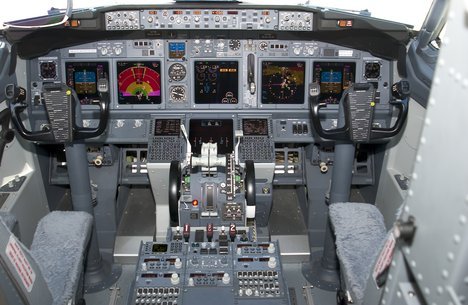
The FAA has ordered airlines to replace or modify the cockpit display units fitted to hundreds of Boeing jets
In addition, the FAA said it was concerned that the screens could be disrupted by mobile satellite communications, cellular signals from phones, and air surveillance and weather radar.
The watchdog noted that the displays were required to provide pilots with information about airspeed, altitude, heading and pitch and roll, and added that the fault could cause a crash.
“We are issuing this AD [airworthiness directive] to prevent loss of flight-critical information displayed to the flight crew during a critical phase of flight, such as an approach or take-off, which could result in loss of airplane control at an altitude insufficient for recovery, or controlled flight into terrain,” it said.
Planemaker Boeing said that it had recommended that carriers implement the changes back in 2012.
However, the FAA said that it had estimated that a total of 1,326 Boeing 737 and 777 jets still needed to make the change.
It estimated that the replacement program would cost about $13.8m (£8.5m) to implement.
The agency noted that Virgin Australia, Air France, Ryanair and Honeywell were among those that had opposed the new rules on the grounds that they did not believe either current in-flight Wi-Fi systems or passengers’ electronic devices emitted signals at a strong enough level to affect equipment on the flight deck.
The FAA said Ryanair had complained that the demands imposed “a high, and unnecessary, financial burden on operators”.
Honeywell had suggested that airlines should be forced to install new screens only if Wi-Fi enabled tablets or other such equipment were used in the cockpit.
However, the FAA rejected these complaints saying it wanted to “eliminate” any risk of interference.
“We do not agree that no problems have occurred on in-service airplanes, since the Wi-Fi… testing that disclosed this susceptibility was conducted on an in-service airplane fitted with phase 3 display units,” it added.
The FAA has given the companies involved five years to swap or modify the components.
Experts said the public should not be alarmed.
The Federal Aviation Administration (FAA) has announced the six states that will host sites for testing commercial use of drones.
FAA picked Alaska, Nevada, New York, North Dakota, Texas and Virginia.
The sites are part of a program to develop safety and operational rules for drones by the end of 2015.
Hitherto mainly used by the military, the potential of drones is now being explored by everyone from real estate agents to farmers or delivery services.
The head of the FAA, Michael Huerta, said safety would be the priority as it considers approval for unleashing the unmanned aircraft into US skies.
Pilots will be notified through routine announcements about where drones are being flown.
FAA said that its decision followed a 10-month process involving proposals from 24 states.
The agency said it had considered geography, climate, location of ground infrastructure, research needs, airspace use, aviation experience and risk.
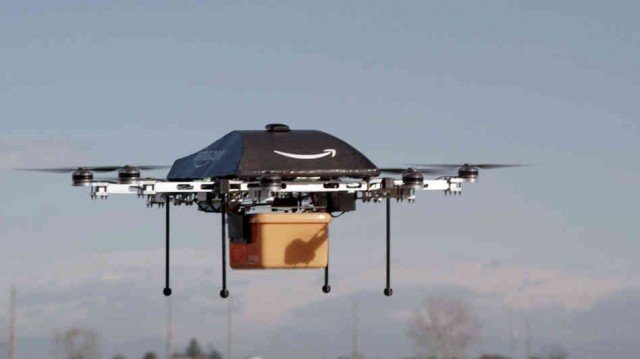
FAA picked Alaska, Nevada, New York, North Dakota, Texas and Virginia for testing commercial use of drones
The sites chosen are:
- A set of locations proposed by the University of Alaska in seven zones with varying climates, from Hawaii to Oregon
- Griffiss International Airport in central New York state will test how to integrate drones into the congested north-east airspace
- North Dakota Department of Commerce will test the human impact of drones and also how the aircraft cope in temperate climates
- The state of Nevada will concentrate on standards for air traffic and drone operators
- Texas A&M University plans to develop safety requirements for drones and testing for airworthiness
- Virginia Tech university will research operational and technical areas of risk for drones
The biggest chunk of the growth in the commercial drone industry is currently expected to be for agriculture and law enforcement.
Police and other emergency services could use them for crowd control, taking crime scene photos or for search and rescue missions.
It can cost a police department hundreds of dollars an hour to deploy a helicopter, while an unmanned aerial vehicle (UAV) can be sent into the skies for as little as $25.
Farmers, meanwhile, might find it easier to spray crops or survey livestock with the pilotless aircraft.
The FAA estimates as many as 7,500 aircraft could be in the air five years after widespread airspace access is made legal.
However, the commercial use of drones has drawn criticism from both conservatives and liberals.
In a report last December, the American Civil Liberties Union said that giving drones access to US skies would only ensure “our every move is monitored, tracked, recorded and scrutinized by the authorities”.
However, lawmakers from winning states were delighted with the selections.
“This is wonderful news for Nevada that creates a huge opportunity for our economy,” said Senator Harry Reid, a Democrat from Nevada.
An industry-commissioned study predicted more than 70,000 jobs – including drone operators – would develop in the first three years after Congress loosens drone restrictions on US skies.
The same study, conducted by the Teal Group research firm, found that the worldwide commercial drone market could top $89 billion in the next decade.
[youtube -QIUBr7vAHI 650]
The US aviation authority has announced the use of portable electronic devices will soon be allowed on US planes during all phases of flight.
The Federal Aviation Administration (FAA) will now permit passengers to use gadgets such as tablet computers and e-readers during take-off and landing.
Many airlines are expected to adopt the new guidelines by the end of the year.
Aviation and mobile technology experts had advised the FAA the rule change would be safe.
“These guidelines reflect input from passengers, pilots, manufacturers, and flight attendants,” Transportation Secretary Anthony Foxx wrote in a statement.
“We believe today’s decision honors both our commitment to safety and consumer’s increasing desire to use their electronic devices during all phases of their flights.”
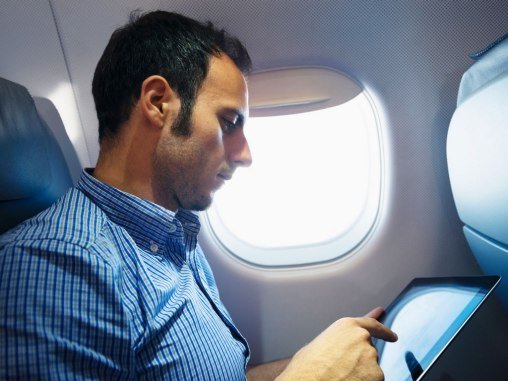
The FAA will now permit passengers to use gadgets such as tablet computers and e-readers during take-off and landing
A review committee recently determined that most commercial aircraft can tolerate radio interference signals from such devices, the FAA said.
Covered under the rule change are lightweight, electrically powered devices including music players, gaming consoles and smart phones – with the mobile telephone service disabled.
Phone calls from mobile phones remain prohibited throughout flights under separate regulations of the Federal Communications Commission.
Individual airlines will have to assess whether their planes can handle the additional radio interference from the devices.
“There is one thing that won’t change,” FAA Administrator Michael Huerta told reporters at Ronald Reagan Washington National Airport near Washington DC on Thursday.
“Passengers must take a break from their devices, their reading material, their music, whatever they are doing, and listen to the safety briefing before each flight. It is information that can save your life.”
[youtube SWWrfFx8t2M 650]
British Airways is to become the first European airline to let passengers switch on their mobile phones and other devices just after landing.
From 1st of July, once an aircraft has got off the runway people can power up their electronics, rather than having to wait until it has stopped.
The Civil Aviation Authority (CAA) has said it is satisfied there are no safety implications.
Airlines from other countries have allowed similar rules for some time.
Passengers have generally been forbidden from using their electronic devices on planes owing to fears of interference, especially when taking off and landing.
BA’s new rules will allow mobiles to be switched on and used as soon as the aircraft is off the runway.
“Customers will no longer have the frustration of having to wait until their plane has arrived at the terminal building before being able to use their mobile phones and other handheld electronic devices,” said Ian Pringle, BA flight training manager.
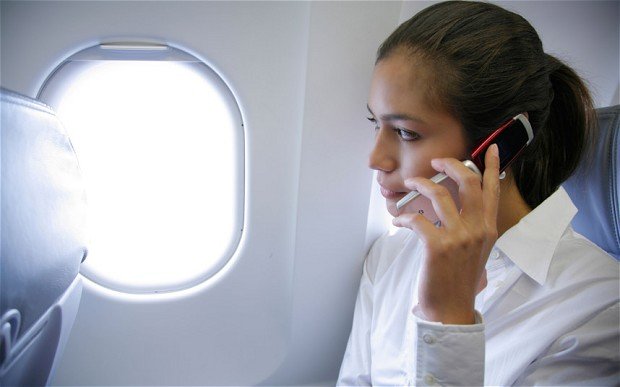
British Airways is to become the first European airline to let passengers switch on their mobile phones and other devices just after landing
“Now they’ll have that extra time to phone ahead for that important business meeting, check their emails, or make sure someone is there to meet them at the airport.”
The rules will not affect restrictions during take-off, however, where devices will still have to be switched off until the plane reaches 10,000 ft (3,050 m).
The change, which will apply to BA flights landing anywhere in the world, is in response to feedback from customers, the airline said.
The Federal Aviation Administration (FAA), the equivalent of the CAA in the United States, has also been looking at allowing wider use of personal electronics on flights.
A draft proposal published last week said existing rules, first drawn up in 1966, had become “untenable” in an age of modern technology and communication.
Several studies later, the FAA has agreed to change guidelines, but is still debating to what degree.
The FAA agreed with experts that advances in technology, both in aviation and consumer electronics, mean any threat of interference is either minimal or non-existent.
But there is greater concern about take-off and landing, with authorities keen both to ensure aircraft equipment is not interfered with and that passengers are not overly distracted at “critical” moments.
It is likely that pressure on aviation authorities worldwide to relax rules has been driven by a major revenue opportunity for airlines.
Technology exists, and is in limited use, for passengers to use Wi-Fi internet and to make calls at high altitude, usually at premium rates.
Any change in policy would be welcome news for actor Alec Baldwin. In December 2011, he was kicked off an American Airlines flight before take-off after refusing to stop playing the popular Scrabble-like game Words With Friends.
American Airlines has decided to ground all flights across the US due to a fault with its computerized reservation system.
The airline company said that all departures would be halted until at least 17:00 ET on Tuesday, and that it was working “to resolve this issue as quickly as we can”.

American Airlines has decided to ground all flights across the US due to a fault with its computerized reservation system
American Airlines says it will offer refunds and allow passengers to change flights for free.
About 900 flights are said to have been affected.
The Federal Aviation Administration (FAA), which regulates civil aviation in the US, confirmed that American Airlines had asked to halt its flights while the problem was rectified.
“Any American plane sitting on the ground anywhere in the US won’t be taking off,” said FAA spokesman Lynn Lunsford.
Airline safety inspectors have found no faults with the battery used on Boeing’s 787 Dreamliner, Japan’s transport ministry has announced.
Dreamliner’s battery was initially considered the likely source of problems on 787s owned by two Japanese airlines.
The world’s entire fleet of 50 787s has been grounded while inspections are carried out.
Attention has now shifted to the electrical system that monitors battery voltage, charging and temperature.
Transport ministry official Shigeru Takano said “we have found no major quality or technical problem” with the lithium-ion batteries. Shares in GS Yuasa, which makes the batteries, jumped 5% on the news.
“We are looking into affiliated parts makers,” he said.
“We are looking into possibilities.”

Airline safety inspectors have found no faults with the battery used on Boeing’s 787 Dreamliner
The safety investigation started after one of the 787s operated by All Nippon Airways made an emergency landing in Japan when its main battery overheated. Earlier, a battery in a Japan Airlines 787 caught fire while parked at Boston’s Logan International Airport.
Two weeks ago the US Federal Aviation Administration said both batteries had leaked electrolyte fluid, and there had been smoke damage to parts of the aircraft.
The FAA said airlines must demonstrate battery safety before flights could resume, a statement that effectively meant airlines had to ground their 787s.
Boeing, which competes against Europe’s Airbus, has halted 787 deliveries. Boeing has orders for more than 800 Dreamliners.
The 787 is the first airliner made mostly from lightweight composite materials that boost fuel efficiency. It also relies on electronic systems rather than hydraulic or mechanical systems to a greater degree than any other airliner.
Boeing’s 787 Dreamliner continues to face problems as more aviation regulators and airlines grounded the plane on safety concerns.
The Federal Aviation Administration (FAA) ordered US airlines to stop using 787s temporarily after a battery fault caused an emergency landing in Japan.
Airlines in Chile and India quickly complied by grounding their Dreamliners.
Boeing said that it stood by the integrity of the 787.
A string of issues have raised questions about the 787’s future.
In recent weeks Dreamliners have suffered incidents including fuel leaks, a cracked cockpit window, brake problems and an electrical fire. However, it is the battery problems that have caused the most concern.
On Wednesday, an All Nippon Airways (ANA) flight made an emergency landing because of a battery malfunction. That caused them to ground all 17 of their Dreamliners and Japan Airways followed suit.
The FAA said that airlines must demonstrate battery safety before flights can resume.
The FAA added that it had alerted the international aviation community of its airworthiness directive so that other authorities could take parallel action to cover the fleets operating in their countries.
Leithen Francis, from Aviation Week, said that could mean more bad news for Boeing in the coming days.
“When the FAA issues an airworthiness directive civil aviation and airlines around the world have to follow the FAA airworthiness directive, particularly in regards to the 787 because it a US-designed and developed aircraft,” he said.

The Federal Aviation Administration ordered US airlines to stop using 787s temporarily after a battery fault caused an emergency landing in Japan
Boeing said it supported the FAA but added it was confident the 787 was safe.
Chief executive Jim McNerney said: “We will be taking every necessary step in the coming days to assure our customers and the travelling public of the 787’s safety and to return the airplanes to service.
“Boeing deeply regrets the impact that recent events have had on the operating schedules of our customers and the inconvenience to them and their passengers.”
Boeing shares closed down more than 3% on Wall Street on Wednesday.
United Airlines, the only US airline currently operating Dreamliners, said it would immediately comply with the FAA’s directive and would begin re-accommodating customers on alternative aircraft.
Chile’s LAN announced it would suspend usage of its three Dreamliners in co-ordination with the Chilean Aeronautical Authority.
Indian aviation regulators also complied by ordering Air India to stop operating its 787s.
“The FAA has issued an advisory to ground the Dreamliners. We took a decision after that,” said director general of civil aviation Arun Mishra.
“As of now there is no clarity on when the Dreamliners will be back in service. Boeing has to satisfy everyone with safety standards.”
Poland’s Lot Airlines, which was due to launch its 787 transatlantic service this week, has also been affected. It went ahead with its first flight from Warsaw to Chicago on Wednesday afternoon, but cancelled the return flight following the FAA’s directive.
All together with the Japanese airlines, who are the Dreamliner’s biggest customers, more than four-fifths of the 787s in use are now not flying.
Leithen Francis said this could have an effect on airlines currently considering ordering 787s, causing them to choose rival Airbus’ A330 instead, which is a comparable aircraft and a proven product.
Late on Wednesday, the FAA said it would work with the manufacturer and carriers on an action plan to allow the US 787 fleet to resume operations as quickly and safely as possible.
“The in-flight Japanese battery incident followed an earlier 787 battery incident that occurred on the ground in Boston on January 7, 2013,” the regulator said.
“The AD [airworthiness directive] is prompted by this second incident involving a lithium ion battery.”
It said the battery failures resulted in the release of flammable electrolytes, heat damage, and smoke, and the cause of the failures was under investigation.
“These conditions, if not corrected, could result in damage to critical systems and structures, and the potential for fire in the electrical compartment,” the FAA said.
[youtube ZgrD8XnSP4s]
US Federal Aviation Administration (FAA) has ordered a review of the 787 Dreamliner plane after a series of incidents put a question mark over the safety of Boeing’s flagship plane.
The review by the FAA will look at the design and manufacture of the planes.
It is not clear whether the planes in the air at the moment will be grounded.
An electrical fire, a brake problem, a fuel spill and cracks in the cockpit’s windshield have affected Dreamliner flights in the past week.
“We are absolutely confident in the reliability and performance of the 787,” Boeing spokesman Marc Birtel said.
“We are working with the FAA and our customers to ensure we thoroughly understand any introductory issues that arise.
“While we take each issue seriously, nothing we’ve seen in service causes us to doubt the capabilities of the airplane.”

FAA has ordered a review of the 787 Dreamliner plane after a series of incidents put a question mark over the safety of Boeing’s flagship plane
The Boeing 787 Dreamliner is one of the most advanced aero planes ever created. Much of it is made from very strong, light carbon-fibre composite material.
However, a spate of technical issues has hurt its image. On Friday, two new problems were found, adding to Boeing’s woes.
- On Friday, All Nippon Airways reported a crack in the window on the pilot’s side of the cockpit. It caused no problems for the 237 passengers and nine crew on a flight from Tokyo’s Haneda airport to Matsuyama, but the return flight was cancelled
- The same airline said another Dreamliner flight, shuttling between Haneda and the southern Miyazaki prefecture, experienced a delay due to an oil leak from a generator inside an engine
- On Wednesday, ANA cancelled a 787 flight from Yamaguchi to Tokyo because of a brake problem
- On Tuesday, Japan Airlines cancelled a Boston to Tokyo flight after about 40 gallons (151 litres) of fuel spilled
- An electrical fire broke out on board a Japan Airlines Dreamliner on Monday shortly after it landed in Boston, following a flight from Tokyo
- Last year, a United Airlines flight was forced to make an emergency landing because of an electrical problem
- In December, Qatar Airways grounded one of its 787 Dreamliners after several manufacturing faults caused electrical problems similar to those that affected the United plane.
Last month, the head of Qatar Airways criticized Boeing over several manufacturing faults that have resulted in the grounding of one of its three 787 Dreamliner aircraft.
Boeing has delivered 50 of the 787s, starting in late 2011, and has orders for nearly 800 more. To get through the backlog, Boeing is increasing production to build 10 of the planes per month by the end of the year.
By comparison, it builds more than one 737, Boeing’s best seller, every day.
Transition, a prototype car made by US company Terrafugia that is licensed to fly as well as drive, has been put on display at the New York International Auto Show.
The car is the first vehicle in the world to have met both the standards of the FAA (Federal Aviation Administration) and the NHTSA (National Highway Traffic Safety Administration), according to Cliff Allen, Vice President of Sales at Terrafugia.
This makes it the first “street legal aeroplane”, he said.
Known as the Transition, the versatile vehicle has two seats, four wheels and retractable wings.
It is expected to be available next year, with a price tag in the region of $279,000.
The vehicle currently has an experimental certificate from the FAA, meaning the company has permission to fly it in US airspace for test purposes. The company hopes in time it will gain a light sport aircraft license.
The hybrid vehicle completed its first successful test flight at Plattsburgh International Airport near Montreal in Canada last month.
A retired US Air Force test pilot took the maiden voyage – after volunteering his services.

The Terrafugia Transition has an experimental certificate from the FAA, meaning the company has permission to fly it in US airspace for test purposes
“We are very fortunate to have found him,” said Dr. Samuel Schwegart, an engineer at Terrafugia working on the project.
The vehicle flew at 1,400 feet for eight minutes.
However, important details still need to be worked out from test data, including the stall speed of the aircraft.
There are significant design challenges marrying a roadworthy vehicle with a skyworthy one, according to Dr. Samuel Schwegart.
“We were curious to see how it would take off,” says Dr. Samuel Schwegart.
“Unlike a normal plane, it cannot rock back on its rear wheels at the moment of take-off, because it is designed to be stable as a car on the road.”
The engineers also found that Transition needed more speed than anticipated on take-off, to generate the necessary lift for ascent.
A hard landing was also reported, but nothing of concern, according to Dr. Samuel Schwegart.
“You can pull up at a regular gas station to fill it up,” says Dr. Samuel Schwegart. A full tank holds 23 gallons (87 litres) of fuel.
It requires Premium 91-octane fuel, and does 35 miles to the gallon (6.7l/100km) on the road, and 28 mile (8.4l/100km) in the air.
“The discrepancy is because of drag,” says Dr. Samuel Schwegart.
Although Transition can be stored in a normal garage, it needs a 1,700-foot (520-metre) runway to take off.
According to Terrafugia, this is no problem, as there are 5,000 state airports in the United States. And there are a further 5,000 private ones, which might just mean a simple runway belonging to a farmer in a field.
Terrafugia calculates that you are rarely further than half an hour from a take-off point – and there are apps like Foreflight which will tell you where the nearest one is, whether you are on the ground, or up in the air hoping to come down.
“You just do your pre-flight checks, unfold your wings and away you go,” says Dr. Samuel Schwegart.
The initial target market was existing pilots, but the company is now reaching out to people with no aviation background.
The vehicle offers an “advanced level of freedom in life, more efficiency in personal travel”, according to a company representative.
Terrafugia currently has 100 pre-orders, which in their current small production facility in Woburn, Massachusetts, already means a two-to-three-year backlog.
With a range of 644 miles (1,035 km) on a full tank, the vehicle could in theory make a non-domestic journey. For the time being, however, the vehicle is restricted by its license to flying in the US.
[youtube aeQL-dUjlOg]
A new aviation rules will allow carriers operating in the South Pacific to take a “short cut” over the North Pole for the first time.
Under the new relaxation of aviation rules, British air passengers will be able to cut the times of long-haul flights by as much as half and fly faster to exotic destinations.
It could also mean cheaper and cleaner flights for holidaymakers.
While pilots from Australia taking passengers to South America will be able to steer more direct courses making big savings in time, fuel and emissions.
Until now, Boeing’s 777 and the new 787 Dreamliner jets had for safety reasons to stay within a three hour range (180 minutes) of the nearest diversion airport.
Under the new rules, that has been nearly doubled to five and a half hours, (330 minutes) taking account of improvements in aircraft and engine technology.
It means, for example, that planes from the UK will be able to take a non-stop flight – dubbed “Santa’s short cut” – over the North Pole to destinations such as Hawaii, Alaska or French Polynesia.
It also means shorter journeys, cheaper flights, less fuel, and lower emissions of carbon dioxide (CO2), the so-called greenhouse gas, which is blamed for global warming.
The “extended operations” rules define the time that an aircraft is permitted to be from an emergency landing site in case of an engine failure and is applied to two-engine jets.
The new regulation follows a decision by the U.S. Federal Aviation Administration to allow up to 330-minutes “extended operations” for Boeings’ 777 fleet.
It allows airlines operating Boeing 777-300ER (extended range), 777-200LR (longer range), 777 Freighter and 777-200ER models equipped with General Electric engines to fly up to 330 minutes from a potential “diversion” airport.
Approval for the Boeing 777-200ER equipped with British Rolls-Royce and American Pratt & Whitney engines is expected to follow over the next few months.
The first airline to take advantage of the new longer “extended operations” option is Air New Zealand which earlier this month flew from Los Angeles to Auckland.
Last October The European Aviation Safety Agency granted a 207-minute rating after receiving an application from Air France to fly a 777-300ER from Los Angeles to Papeete, Tahiti. The European agency is also expected to adopt the 330-minute rule.
Planes once flew over the North Pole during the Cold War in the 1950s to avoid Communist Bloc airspace.










